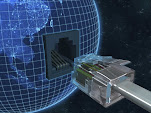Provides connectivity and path selection between two host systems that may be located on geographically separated networks.
Packets
Virtual circuits
Route, routing table, routing protocol
Logical address
Fragmentation
Responsible for the correct addressing and delivery of packets of data
These are known as datagrams
Uses the network address ( this is a logical address – and does not depend upon any hardware in the device, or the device’s physical location)
The Network Layer does the following:
Adds the address to the packet (encapsulation)
Maps the network address to the devices physical address
Determines the best path for the packet (routing)
Ensures that the packet is in the correct format for the destination
Protocols--IP; ARP; RARP, ICMP; RIP; OSFP; IGMP;IPXNWLinkNetBEUI.
Devices that mainly work on this layer—Brouter, Router.
Encapsulation at the Transport Layer involves adding the address of the sender to the datagram.
The destination address is now added. Both addresses are logical.
Both addresses are necessary for packets to move between end systems.
If a packet must move to another network, a routing protocol is required.
If different packet lengths are used on the different networks, the Network Layer formats the data accordingly The primary piece of hardware which works on this layer is the router.
Packets
Virtual circuits
Route, routing table, routing protocol
Logical address
Fragmentation
Responsible for the correct addressing and delivery of packets of data
These are known as datagrams
Uses the network address ( this is a logical address – and does not depend upon any hardware in the device, or the device’s physical location)
The Network Layer does the following:
Adds the address to the packet (encapsulation)
Maps the network address to the devices physical address
Determines the best path for the packet (routing)
Ensures that the packet is in the correct format for the destination
Protocols--IP; ARP; RARP, ICMP; RIP; OSFP; IGMP;IPXNWLinkNetBEUI.
Devices that mainly work on this layer—Brouter, Router.
Encapsulation at the Transport Layer involves adding the address of the sender to the datagram.
The destination address is now added. Both addresses are logical.
Both addresses are necessary for packets to move between end systems.
If a packet must move to another network, a routing protocol is required.
If different packet lengths are used on the different networks, the Network Layer formats the data accordingly The primary piece of hardware which works on this layer is the router.



Post a Comment